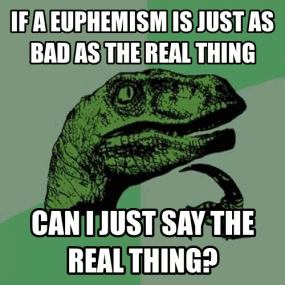An older post by Stan Hingston on the urgent need of many people to demand others use their chosen euphemisms, especially when the word objected to is itself already a euphemism:
Stephen Pinker in his 2003 book The Blank Slate coined the name euphemism treadmill for the process whereby words introduced to replace an offensive word, over time become offensive themselves. A current example of this is mental retardation.
The word itself comes from the Latin retardare meaning “to make slow, delay or hinder”.
Retardation was first used in the psychiatric sense in 1895, and eventually replaced older terms – once neutral themselves – like moron, imbecile, idiot, feeble-minded and cretin. Each of these terms had a specific meaning as to severity and age of development (cretinism for example referred to severe congenital hypothyroidism) but these meanings often differed between countries. The new term was subdivided into degrees of mild, moderate and severe mental retardation. These new technical terms were no doubt welcomed by those affected, as the previous names were being used as derogatory insults (as indeed they still are).
By the 1960s when I was in grade school, the same process had occurred with retardation. “Retard” was a common playground insult, as in “Look where yer goin’, ya retard!” To us at the time it was considered harmless fun (although I now recognize the potential to really hurt someone who did have an intellectual disability). In Grade 7 my buddy Doug and I did impersonations of “retarded chipmunks” in which we tucked our lower lip inside our upper front teeth and crossed our eyes.
Since that time retardation has been gradually replaced by a variety of more acceptable (at least for now) terms including mentally handicapped, mentally impaired, mentally challenged, intellectually challenged, intellectually disabled, learning disabled, and developmentally disabled. The last two of course are broader terms that include other conditions not covered by the meaning of mental retardation.
The problem of technically defined terms being appropriated by “the masses” and misused is not soluble by professional bodies, and given the flexibility of the English language, probably not even by a French-style “official language commission” empowered with all the majesty of law: it would be a massive waste of time and effort. Of course, “massive waste of time and effort” is pretty much baked into the bones of government agencies…





